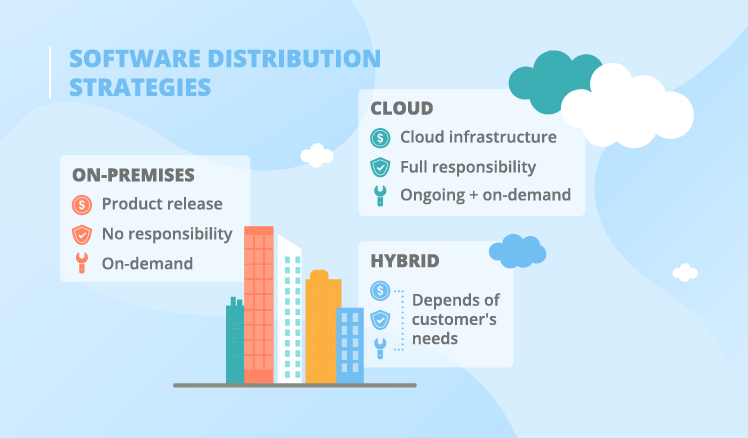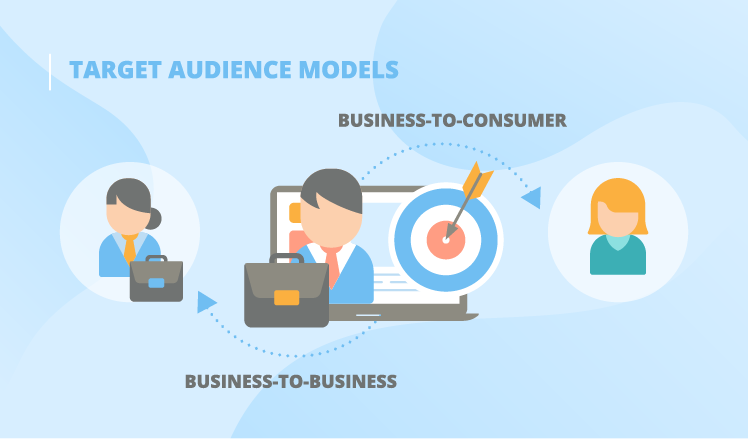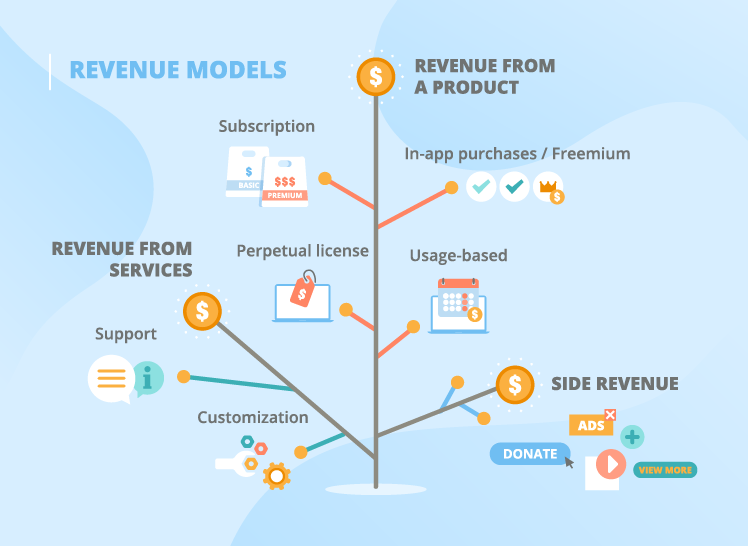Software Business Models: What Works for Your Product?
You may believe in the success of your software product already after shaping its idea, but it’s not the concept alone that moves you up in the world. In order to achieve success, you have to first figure out in what way and to whom you will deliver your product, as well as how you will profit from it.
Drawing on our outsourced software product development expertise, we talk about the technical specifics, costs, and responsibilities involved in each of the possible options, helping you understand what works best for you.
Software distribution strategies
To deliver software to your clients, you can use one of the following software distribution options:
- Making a product installable on a customer’s premises.
- Making a product available online via cloud hosting (also known as the ‘software-as-a-service’ distribution)
- Combining these two strategies (the ‘hybrid’ distribution).
We examine all three of them, paying attention to the costs, data security, and support services you’ll have to provide.

On-premises
This model is commonly used for software products that have to continuously and reliably deliver high performance (for example, during the work with heavy graphics) or to process highly sensitive data (patients’ health data). Your target audience would also prefer to have your product installed on their hardware if they operate in the field (for instance, software for geologists and engineers) or don’t have a stable network connection for some other reasons.
According to this strategy, you let anyone who buys your software product handle installation, synchronization, and general maintenance such as version updates, so the distribution costs in the on-premises model are mainly associated with the product release. You can choose to offer your software in popular online shops and let users buy it from there, or you can decide to sell your product on your own website. While the first option suggests a number of fees to the distributors, it may still be cheaper than investing in the promotion campaign for your website, if you’ve just started out.
Since you let users install your product on their hardware, you don’t bear any responsibility for their data security in most circumstances, the only exclusion being a security breach in your software. Any support service you provide will be on-demand. However, resolving some customer issues – for instance, those related to integration – may be challenging since support specialists won’t have direct access to installed software and will need to carefully guide users through performing necessary tuning.
Cloud (SaaS)
With today’s high quality of internet connection, cloud hosting is a fitting option for almost all software products, excluding those we’ve mentioned in the on-premises case.
The distribution costs in this strategy are associated with cloud infrastructure. Instead of building and maintaining your own data center right away, you’ll most likely turn to Amazon Web Services, Microsoft Azure or other popular cloud hosting companies. Depending on the storage and computing power your product will need, you can choose a suitable pricing plan.
With the cloud model, you’re fully responsible for data security and availability of your services. However, since you’ll be relying on third-party cloud hosting vendors, you won’t have complete control of what you’re responsible for. Still, the services of large and recognizable cloud hosting brands can surely be trusted.
Support in this model can be considered a part of the offer and be both an ongoing and an on-demand service. On-demand support will tackle issues related to user behavior and address integration errors and misconfiguration as well as provide general guidance in using the software. Special training, organized for a client company’s employees, can be a part of such support.
One of the tasks of the ongoing support is to pin down defects in software and prioritize their fixing in production. Another important task is handling such an unwanted but inevitable situation as downtime. Even though cloud hosting brands promise almost-100%-uptime, you should understand that even 99.9% uptime (or ‘three-nines uptime’) means 10 minutes of weekly and nearly 9 hours of yearly downtime. It’s crucial to develop a data backup and recovery strategy as well as always have a plan on how to communicate the details of downtime to your users.
Hybrid = SaaS + on-premises
According to this strategy, you let your clients have your product installed on-premises and also enable cloud services so that your users can take advantage of them if needed. For instance, some companies would prefer to perform their common daily tasks in the cloud while storing sensitive and private data locally.
The costs, responsibility for data security and support service in this model all depend on how the two strategies are balanced out in your hybrid offer. In many cases, it’s your clients who determine this balance as each of them has individual needs for local and cloud usage. If you don’t want to keep creating custom hybrid models for every client, consider offering a number of pre-made plans that address most popular user needs.
Target audience models
The distribution strategy can’t be chosen without the target audience model in mind. Below we describe the two most popular target user models and show you how each of them corresponds to the distribution strategies.

B2B
The target audience in the B2B model includes business entities, who purchase and use your software product. Since such clients call for complex sales, you’ll need a dedicated and trained sales team, who will be able to hold negotiations with business representatives.
Having businesses as your clients allows you to provide product-related services that will bring you additional revenue. For instance, you can offer the integration of your product with your client’s in-house software or data migration from a different solution to yours. For this, of course, you will need a team of trained tech professionals on board.
Hybrid distribution is applied in this model way more often than in B2C, since it’s companies, not individual users, who usually have highly sensitive data which they wouldn’t risk to store in the cloud. Both SaaS and on-premises distribution models are equally great choices for the B2B model as well.
B2C
According to the business-to-consumer model, a software product is delivered to individual users. Unlike the B2B model, you can offer general on-demand support services here that won’t make you hire tech specialists with specific industry knowledge. There’s no need for a dedicated field sales team either: your target audience is wide and diverse, so actively promoting your software via digital marketing is the best way you can find future customers.
Although support and sales in B2C are simpler, it’s more difficult to collect feedback and evolve the product according to customers’ expectations since you don’t build a direct communication with each consumer. You may want to introduce regular in-build surveys and application performance monitoring tools in your product in order to gather useful data on the flaws and shortcomings of your software.
Both the on-premises and cloud models are applicable here, with the latter gaining more and more popularity. Consumers appreciate it when they don’t have to bother with software installation or maintenance on their own and enjoy using products that are easily available online.
Revenue models
Once you know to whom and how you will distribute your product, it’s time to think about the way to receive income from it. Here we list possible revenue models, grouped according to the major source of income.

Revenue from a product
- Perpetual license
You sell your software product at a set price and profit from the sales. This model is common for the on-premises distribution and is hardly applicable to the cloud since you can’t sell a perpetual license for the services you continuously provide to multiple users and have full control of.
- Subscription
You offer your clients pre-paid plans and let them sign up for using your software product for a certain amount of time or a number of users. This is a model commonly used for SaaS products, allowing users to opt in and out of using your product at any moment. However, it applies to the on-premises software as well.
- In-app purchases/Freemium
You can let your clients take advantage of a part of your product’s functionality for free and ask for payment to enable additional features. Another option is to set a ‘trial period’ and let users enjoy all the features for a limited amount of time. After that, you lock either the entire functionality or a part of it until a user makes a payment.
- Usage-based
With the usage-based model, you regularly charge customers for using your software the way a utility company charges for electricity. Such a model is rarely used as a stand-alone offer and is most often a part of the subscription offer, allowing users, who don’t yet know what plan works best for them, to figure out their needs.
A variety of this model is a 'transaction fees' model where you charge users for certain transactions performed with the help of your software product. For instance, your product performs automatic purchasing of third-party services, and you charge customers a fee every time they trigger this automatic action.
Revenue from services
Product services can be a great source of income and often constitute from 20% to 60% of software companies’ revenue.
- Support
You can choose to make your product completely free and instead get revenue from support services. This is a great option for software products that require complex setup or integration since your clients will definitely need your help after making a purchase. Alternatively, you can offer paid support services while still asking to pay for the product itself. To not appear too greedy in your clients’ eyes in this case, you might want to lower the price of the product.
- Customization
Choosing to receive revenue from customization can work great for products that target a wide audience with diverse needs. Usually, such products provide a general functional basis that can be expanded and catered to a customer’s individual needs. Purchasing such a product and paying for customization is more cost- and time-effective for clients than investing in custom development from scratch, so this model will definitely help you gain a wide audience of users.
Side revenue
You don’t have to stick to one source of income only and can receive additional revenue from ads, affiliate links or even voluntary donations. However, it’s not recommended to make these sources your only source of revenue since they’re quite unstable. Start thinking of side revenue models after you choose one of the models described above.
On a final note
Creating a successful business model helps your product receive deserved recognition and bring you well-earned profit. Take your time with the choice of distribution, target audience, and revenue models to make sure they bring out the best in your software product idea.

